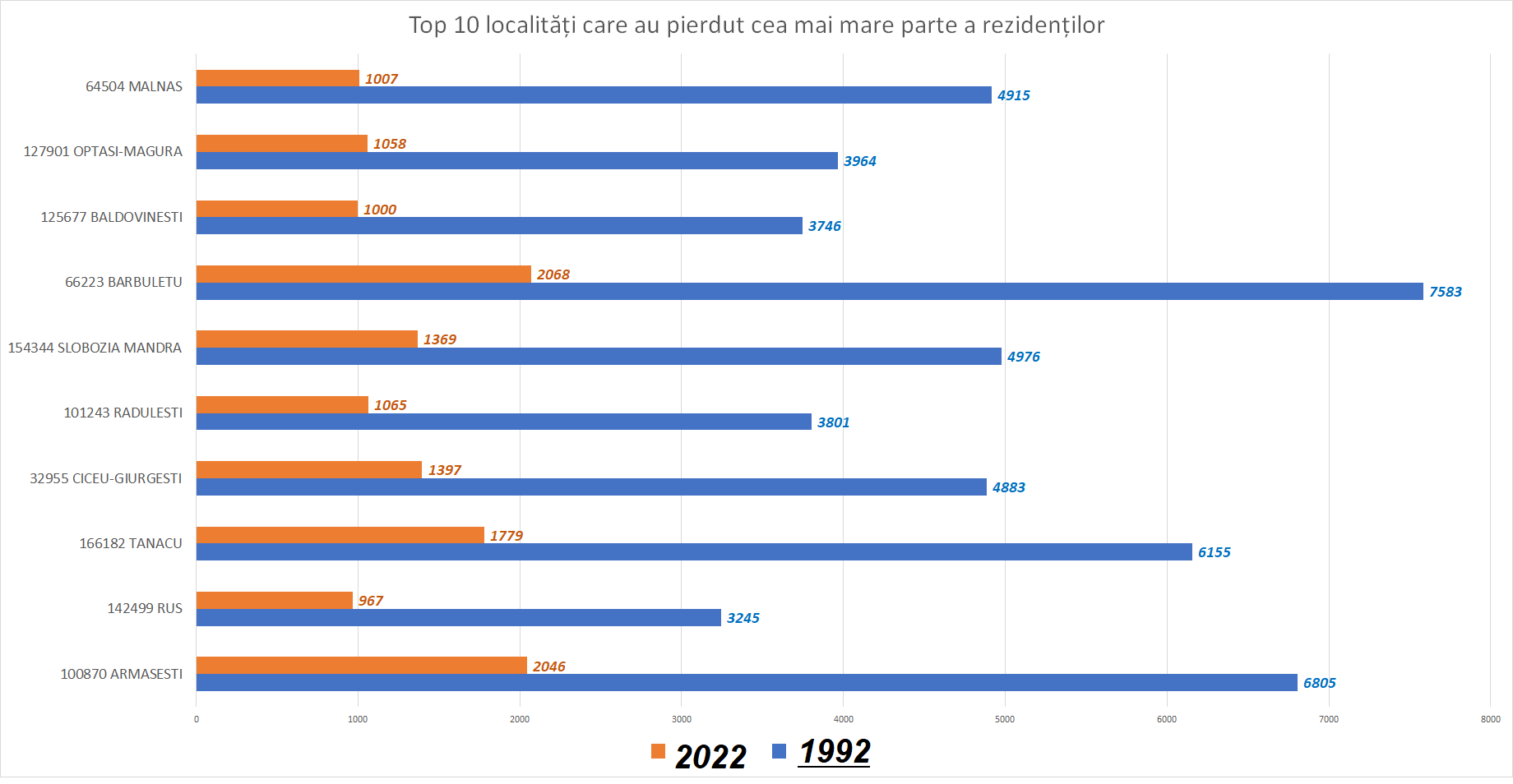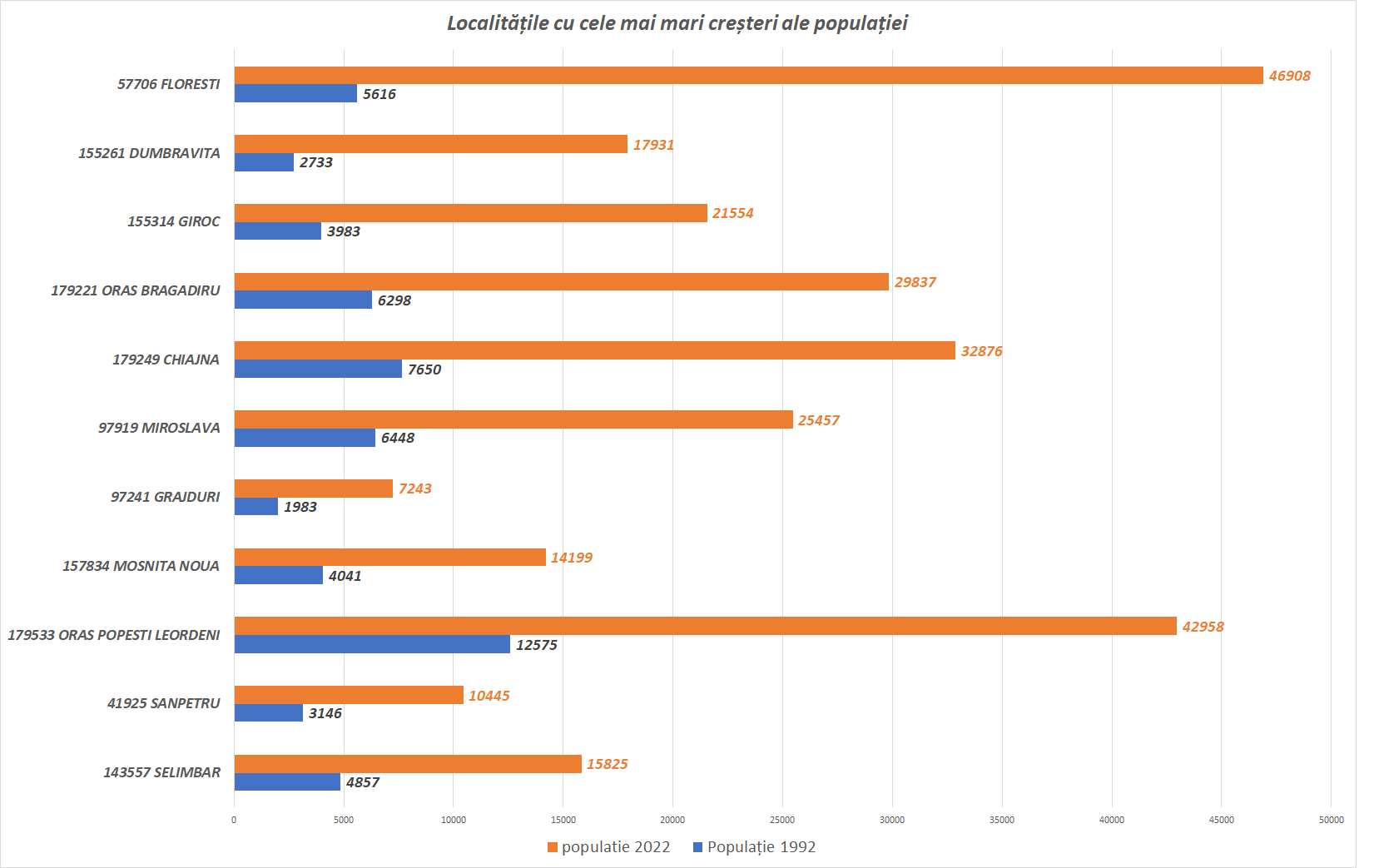
Many Romanian cities were left deindustrialized after factories closed, leaving a large part of the population without work and forcing people to look for work elsewhere. While some cities are growing rapidly, the cities you’ll see below are moving in the opposite direction as they lose more and more residents. When people leave, the economy shrinks, which leads to an increase in crime, which increases people’s desire to leave.
1st place: Malnaș (Zmeuriș), Covasna
30 years ago there were 5,000 inhabitants. Now there are about 1,000 of them. It has lost about 80% of its population. True, this happened as a result of the separation of some villages from the Malnas, but also against the background of mortality and migration.
According to the city’s strategy, published on the city hall’s website, in recent years the level of migration from the commune of Malnas exceeds the average indicators of the county of Covasna.
Migration affects the demographic structure, as among the age group of young people there is a greater tendency to emigrate. As a result of the emigration of young people, the share of the elderly in the population increases, which also means a decrease in terms of productivity.
The commune of Malnash has a building for a dispensary, but it is necessary to purchase the necessary equipment, and even more importantly to attract a family doctor to Malnash, since access to the local population is not guaranteed.
to basic medical services, as there is no family doctor in the commune, the said Strategy says. Emergency care and hospitalization needs are handled at the Sfantu Gheorghe District Hospital.
The lack of a family doctor, and therefore the almost complete lack of medical services, is a huge problem at the local level from the point of view of health care. As a result, the chronically ill and the elderly are in an extremely difficult and vulnerable position, having to travel regularly to Sfantu Gheorghe to receive prescriptions and undergo basic tests and analyses, which is impossible for them.
Second place: Optashi-Magura-Alt
In second place we find the city 35 km from Slatina. Optasi-Magura is a commune in Olt County, Muntenia, Romania. Enabled – it is written on the website of the mayor’s office that it consists of 3 farms, and the activities of people in this area are agriculture and animal husbandry.
Like many other places in Romania, you don’t really have anywhere to work to earn money and raise a family. So it’s not surprising that out of almost 4,000 residents (30 years ago), 1,000 people still live there (1,058, if the INS figures are to be respected).
Third place Baldovinest – district of Alt
Out of 3,700 residents, there are now about 1,000.
Baldovinest has three villages: Baldovinest, Pietris and Gubandu. Located in the north-western part of Olt County, 32 km from the municipality of Slatin and 5 km from the town of Bals.
The commune has an agricultural area of 1,531 hectares of agricultural land with pastures, hayfields, vineyards and orchards. Among agricultural crops, the largest share is wheat and corn. The forest fund of the commune is represented by 473 hectares of forest, of which 7 hectares are privately owned. Animal husbandry is of particular importance at the commune level.
Place 4 Barbuletsu-Dambovitsky district
Of the 7,500 inhabitants 30 years ago, today only 2,000 remain.
Lack of jobs. The area is disadvantaged, the main activity of the population is fruit growing and animal husbandry. The population is getting older, the mayor’s report also shows.
5th place Slobozia Mandra, Teleorman
The legend about the name of the area says that it comes from a boyar who freed his peasants – “my freemen” (slobozhan). “Proud” from a very proud but ugly barmaid. They also say that the local residents of this commune have always been revolutionary (tragic events were recorded in Raskoal in 1907, evidence of which is a monument in the yard of the House of Culture).
In 1992, there were almost 5,000 residents here. Now there are about 1,300 of them left.

Settlements with the largest population growth

First place Florest, Cluj
The city with the youngest and most educated population in Romania is not the capital, as we like to think. According to a recently published World Bank report, this is a commune near Cluj, more precisely the Floreşti area. The report analyzes the county of Cluj from a demographic point of view and suggests scenarios for its development.
The commune of Florest is distinguished by its official population of 38,257 inhabitants, it is the rural settlement with the largest population in Romania. Comparing other rural areas, we note the existence of two more municipalities with more than 10,000 inhabitants, Apahida and Bachiu, which surpass the urban settlement with the smallest number of inhabitants, Huedin (9,527 inhabitants).
If for Florești we are talking about a total population increase of 205 per thousand, then in the case of Cluj-Napoca the value is 2 per thousand.
The commune with the largest population in relation to the area is the commune of Florești, with a population density of 628 inhabitants/km2, which even exceeds the density of urban settlements in the county (with the exception of the municipalities of Cluj-Napoca and Campia-Turzii). .
Over the past 30 years, the population of Florest has grown by more than 700%
2nd place: Dumbravica, Timișoara
According to a specialized study carried out 10 years ago by the Regionalization Advisory Council, the commune of Dumbravica was the most developed and richest area in Romania. Thanks to the rapid development in recent years, the area has joined the territory of the municipality of Timisoara.
Over the past 30 years, the population of Dumbravica has grown by more than 550%.
3rd place: Hirok, Timișoara
The Zhirok commune consists of the villages of Girok and Kishoda, and the village of Girok is the center of the commune. At the same time, it is part of the suburban settlements of the municipality of Timişoara, from which it is separated by only 3 km on an asphalt road. In the last 10 years, thanks to the construction and development of the district in the area of Planishte and Ogrindova (Kvitkovi district), the connection between Girok and Timişoara was practically implemented.
The administrative territory of the commune is bordered in the north by the municipality of Timișoara, in the east by the commune of Mosnica-Nou-Urseni, in the south by the river Timis, in the southwest by the commune of Šag, and in the southwest by the commune of Šag. From Utvin village, Sanmigayul Roman commune.
The natural conditions in this area, halfway between Bega and Timișoara, as well as the existence in close proximity to a large economic center, contributed to the settlement of a large population in these places.
As a general feature, an increase in the number of inhabitants can be observed until about the First World War, when, in addition to a high natural increase, there is also an increase due to migration. Thus, in the period 1865-1870, several German families from Grabati, Lenauheim and Varias bought land in Giroca and moved to the hearth of the village.
In 1910-1912, other German families, this time from Nitchidorf, for the same economic reasons, moved to the border of Hirok, in a place called “Nemți”, a little more than 1 km south-south of the hearth of the village, and founded a farm that included 12-15 houses. The farm existed until about 1921, after which the inhabitants moved to the village, where they built houses. The earliest record of the number of houses dates from 1717, when 70 houses are mentioned, so that in an interval of 60 years, in 1776, the number of houses stands at 199, which of course also attracts a proportional increase in population, estimated per 1,000 inhabitants.
Over the past 30 years, the population has increased by more than 440%
4th place: Bragadiru, Ilfov
Bragadiru is a town in Ilfov County, Muntenia, Romania. The city is located in the southwestern outskirts of the city of Bucharest, at the exit to Alexandria, being a satellite city of the capital. According to the 2011 census, Bragadiru has a population of 15,329 inhabitants, being the fifth urban center of Ilfov county in terms of demographics, after Voluntari, Pantelimon, Bufti and Popesti-Leordeni.
From 1992 to 2022, the population increased by more than 370%
5th place: Chiajna
After 1990, part of the population of Bucharest returned home (to Chiažno) and the other part chose a second home in a cleaner and calmer environment, there was a need to expand the urban territory on almost the entire administrative surface, which led to a sharp reduction in agricultural production in favor of the development of other industries. In the future, with the construction of the expressway, it is possible that the population migration from Bucharest to Chiaina will be impressive. In the field of agricultural production, agricultural activity has significantly decreased, and animal husbandry practically does not exist, says the Strategy published on the website of the City Hall.
From the point of view of the comfort of housing, the commune has a high level. The only remark that needs to be made is that the water supply is not centralized, but individually from own wells.
Sewerage is solved in a single system, and the degree of electrification is approaching 100%, or rather 98.4%, the document also states.
Source: Hot News
Mary Robinson is a renowned journalist in the field of Automobile. She currently works as a writer at 247 news reel. With a keen eye for detail and a passion for all things Automotive, Mary’s writing provides readers with in-depth analysis and unique perspectives on the latest developments in the field.